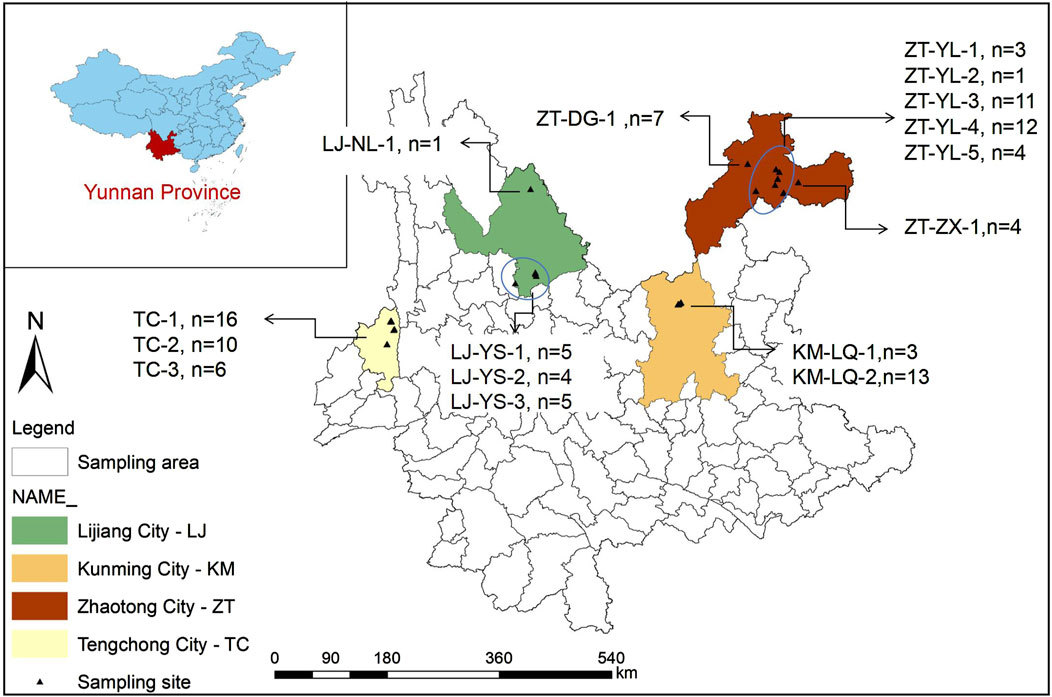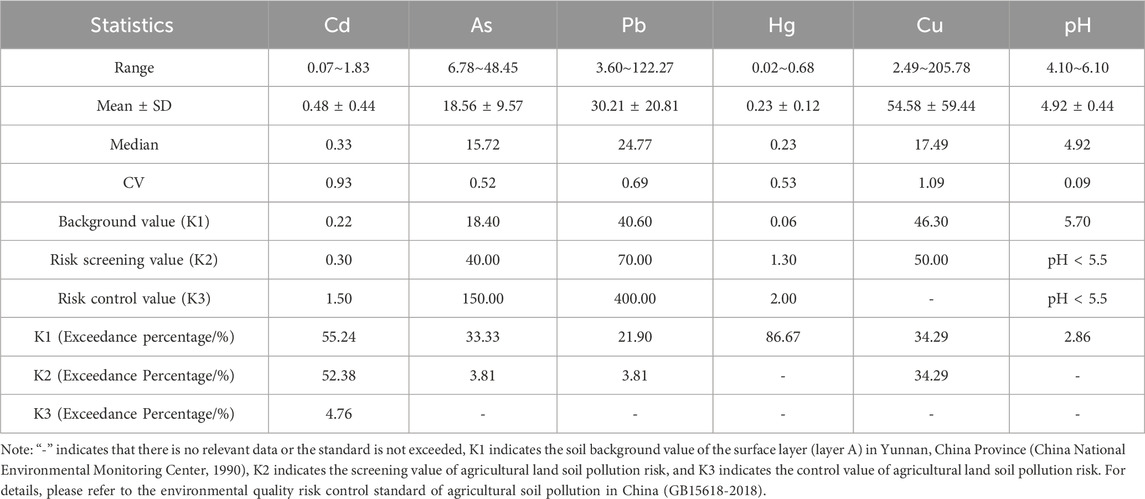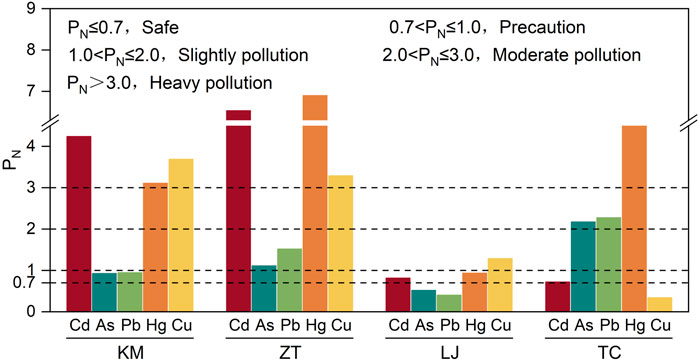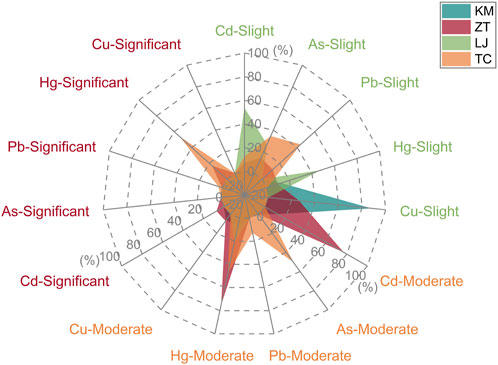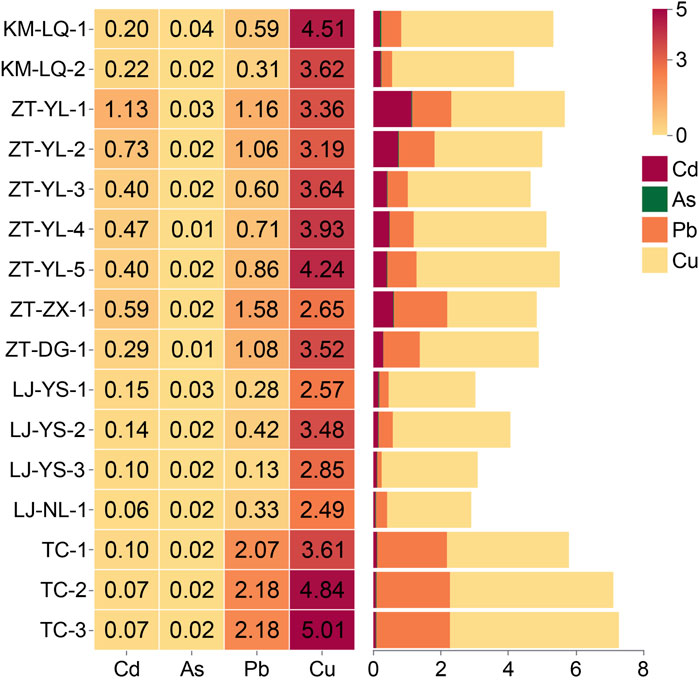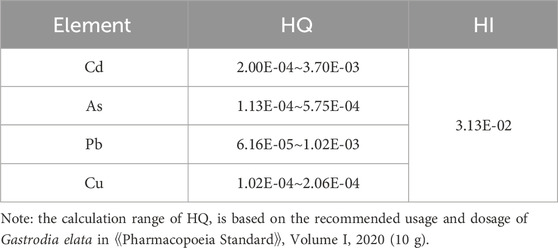- 1College of Resources and Environment, Yunnan Agricultural University, Kunming, China
- 2The Key Laboratory of Medicinal Plant Biology of Yunnan Province, Yunnan Agricultural University, Kunming, China
- 3National and Local Joint Engineering Research Center on Germplasm Innovation and Utilization of Chinese Medicinal Materials in Southwest China, Yunnan Agricultural University, Kunming, China
- 4College of Food Science and Technology, Yunnan Agricultural University, Kunming, China
Introduction: As a newly recognized medicinal and edible Chinese herbal medicine, the safety of Gastrodia elata has garnered significant attention. Yunnan Province is the main production area of G. elata in China, but there is a lack of systematic assessments of the distribution patterns of heavy metals in the soil-plant system and their associated human health risks.
Methods: This study evaluated the pollution status of five heavy metals—cadmium (Cd), arsenic (As), lead (Pb), mercury (Hg), and copper (Cu)—in the surface soil (0–20 cm) and G. elata tubers across four major planting areas: Kunming (KM), Zhaotong (ZT), Lijiang (LJ) and Tengchong (TC) in Yunnan Province. The concentrations of heavy metals in soil and G. elata tubers were determined using inductively coupled plasma mass spectrometry (ICP-MS) and atomic fluorescence spectrometry (AFS). The pollution status of heavy metals in soil was evaluated using the single pollution index (Pi), comprehensive pollution index (PN), potential ecological risk index (PERI), and enrichment factor (EF). The bioconcentration factor (BCF) was applied to assess the accumulation capacity of heavy metals in the plants, while the target hazard quotient (HQ) and total hazard index (HI) were used to evaluate the human health risks associated with heavy metals in G. elata tubers.
Results and discussion: The findings revealed that the surface soils in the sampling areas were acidic, with total nitrogen (TN), total potassium (TK), soil organic matter (SOM), and cation exchange capacity (CEC) reaching abundant levels, while total phosphorus (TP) was relatively low. The pollution levels of the five heavy metals were ranked as Hg > Cd > Cu > As > Pb, with Hg, Cd, and Cu identified as severely polluted. The potential ecological risk assessment indicated a moderate risk, with ZT showing the highest comprehensive pollution level and ecological risk. The enrichment capacity of heavy metals in soil was ranked as Hg > Cd > As > Pb > Cu, while in G. elata tubers it was Cd > Cu > Pb > As. However, there was no significant risk to human health. Correlation analysis indicated that soil Cd and Pb were significantly positively correlated with their respective heavy metal content in G. elata (P < 0.05/P < 0.001). This study provides a scientific basis for controlling soil heavy metal pollution in G. elata planting areas and for assessing the safety of Chinese herbal medicines.
1 Introduction
Traditional Chinese medicine (TCM) herbs are fundamental components of ancient medical system, increasingly gaining global prominence due to their unique therapeutic effects and relatively mild side effects (Zhang et al., 2013; Ekor, 2014). In recent years, driven by a growing inclination towards natural remedies, the global market for TCM herbs has expanded significantly, with projections estimating it will surpass $150 billion by 2025 (Hu et al., 2020; Zhang L. et al., 2021). As the leading producer and consumer of TCM herbs, China plays a crucial role in the global herbal medicine industry. However, this rising demand has brought about concerns related to the quality and safety of TCM herbs, particularly regarding heavy metal contamination (Yang et al., 2021; Liu J. J. et al., 2024). Research indicates that many TCM herb species possess a pronounced capacity for heavy metal accumulation due to their unique physiological characteristics. Coupled with their relatively long cultivation cycles, this has resulted in widespread instances of heavy metal contamination, often exceeding safety standards (Wang et al., 2019; Chen et al., 2020).
Heavy metal contamination not only diminishes the medicinal value of TCM herbs but also poses potential health risks. Common heavy metal contaminants found in TCM herbs include cadmium (Cd), arsenic (As), lead (Pb), mercury (Hg), and copper (Cu), which can lead to toxic effects such as neurotoxicity, liver and kidney damage, and carcinogenicity (Harris et al., 2011; Luan et al., 2015). Analyses of herbal samples from various regions in China have shown that at least one-third contain heavy metals at levels above the limits set by U.S. dietary supplement (NSF/ANSI Standard 173) (Harris et al., 2011). A study of 131 batches of herbal samples reported exceedance rates of 16.79% for Cd and 11.45% for Pb (Luan et al., 2015), while a more extensive examination of 2,427 batches highlighted severe Cd contamination with a 20.9% exceedance rate (Fei et al., 2021). Moreover, regulatory standards for heavy metals vary globally. For example, the limits for Cd, As, Pb, and Hg in China’s “Green Industry Standards for the Import and Export of Medicinal Plants and Preparations” are lower than those in the United States and the European Union (Chen et al., 2020; Fei et al., 2021). Therefore, evaluating the safety of TCM herbs based on current Chinese standards may lead to heavy metal contamination issues becoming a significant bottleneck for the external development of the TCM herbs industry.
Gastrodia elata, a perennial herbaceous plant of the Orchidaceae family, is one of the most valued TCM herbs and features a unique symbiotic relationship with medicinal fungi (Zhan et al., 2016). Its primary active components constituent—gastrodin, phenolic compounds, polysaccharides, and organic acid—endow G. elata with remarkable pharmacological properties, particularly in treating neurological disorders (Zhu et al., 2019). Clinical studies affirm its efficacy in managing headaches, epilepsy, and cardiovascular diseases (Zhan et al., 2016; Lu et al., 2022). Unlike many TCM herbs, G. elata is a heterotrophic, relying entirely on fungi such as Armillaria sp. for nutrient acquisition (Liu Y. et al., 2024). However, studies suggest that these fungi may also facilitate the absorption for certain heavy metals, raising concerns about potential contamination in G. elata (Ferrol et al., 2016; Yin et al., 2021; Goswami et al., 2023).
Yunnan Province is the main planting area of G. elata in China, with both its planting area and output ranking first nationwide (Wang et al., 2023). The unique geographical and climatic conditions in Yunnan create an excellent environment for G. elata cultivation, but they also pose potential risks of heavy metal pollution. Studies have shown that the background values of heavy metals in Yunnan’s soil are generally high, with Cd, Pb, and Hg levels exceeding the national averages (Xu et al., 2024). Soil heavy metal pollution in G. elata planting areas displays both regional and composite characteristics, and environmental factors from different planting sites significantly influence the heavy metal content in G. elata (Jin et al., 2022; Chen and Deng, 2025; Huang et al., 2025). As one of the main planting regions, Zhaotong in Yunnan has been the subject of studies investigating the heavy metal content in soil and G. elata, but the scope of related research remains limited (Xu et al., 2018; Zhao et al., 2018). In contrast, research on emerging planting areas such as Lijiang, Kunming, and Tengchong remains relatively limited. Moreover, most existing studies have concentrated on the heavy metal content, pesticide residues, and sulfur dioxide residues in commercially available G. elata products (Zhang et al., 2018; Yan et al., 2021; Huang et al., 2024).
This study systematically investigated the heavy metal pollution status in the main G. elata planting areas of Yunnan Province. It aims to comprehensively analyze and assess the distribution characteristics of five key heavy metals in both soil and G. elata samples, and further identify the spatial distribution of soil heavy metals and the physicochemical properties of the soil in different G. elata planting regions. This research will not only provide a scientific foundation for sustainable development of Yunnan’s G. elata industry but also offer significant theoretical and practical insights for ensuring the quality and safety of TCM herbs.
2 Materials and methods
2.1 Sample collection and processing
This study collected G. elata tubers and soil samples from major cultivation regions in Yunnan Province between December 2023 and January 2024 (Liu et al., 2015). The sampling locations included: Luquan County, Kunming City (KM-LQ, 16 sites); Yiliang County (ZT-YL, 31 sites), Zhenxiong County (ZT-ZX, 4 sites), and Daguan County (ZT-DG, 7 sites) in Zhaotong City; Yongsheng County (LJ-YS, 14 sites) and Ninglang County (LJ-NL, 1 site) in Lijiang City; and Tengchong City (TC, 32 sites) (Figure 1). The sampling area encompassed latitudes N25 18′53″to N27 55′10″, longitudes E98 34′52″to E104 30′48″, and elevations ranging from 1,379.21 to 3,434.68 m (Supplementary Table S1). G. elata predominantly grew in environments characterized by Cyclobalanopsis glauca, Pinus yunnanensis, and Quercus dolicholepis, with soil types including red, brown, yellow-brown, and yellow soils (pH 4.10–6.10) (Tian et al., 2016; Zhang M. et al., 2021). To ensure the representativeness of the samples and the reliability of the data, this study employed a five-point sampling method at each site to collect surface soil (0–20 cm). The 1 kg of soil was collected from each of the five points and combined to form a single composite soil sample, resulting in a total of 105 mixed soil samples. The soil samples were air-dried indoors, and after drying, impurities such as dead branches, fallen leaves, and stones were removed. The soil was then ground using wooden tools and passed through a nylon sieve. The processed soil samples were preserved for future analysis. At each sampling site, 3 G. elata plants were also collected, yielding a total of 315 tuber samples, which were further grouped into 16 composite samples based on the variations in geographical names (Supplementary Table S1). The tuber samples were sequentially washed with tap water and deionized water, and excess surface moisture was removed with absorbent paper. Subsequently, the tubers were steamed in a steamer for about 10 m to ensure there was no white core. After that, the tubers were sliced and dried in a 65°C oven for 72 h until they reached a constant weight. Finally, the samples were pulverized, sieved, and stored in polyethylene self-sealing bags for subsequent analysis (Sun et al., 2016; Huang et al., 2025).
2.2 Indicator determination
2.2.1 Determination of soil physicochemical properties
Soil samples sieved through 2 mm or 0.149 mm (100-mesh) sieves were measured to determine physicochemical properties: pH, total nitrogen (TN), total phosphorus (TP), total potassium (TK), soil organic matter (SOM), and cation exchange capacity (CEC). The pH was determined using the electrode method. Soil was mixed with deionized water at a water-to-soil ratio of 1:2.5, shaken, allowed to settle, and the supernatant was analyzed with a pH meter (Xu et al., 2021). TN was determined using the semi-micro Kjeldahl method; TP was measured using the NaOH fusion-molybdenum antimony anti-spectrophotometric method; TK was assessed using the NaOH fusion-flame photometric method; SOM was analyzed using the potassium dichromate volumetric method with external heating; CEC was measured employing the 1 mol/L ammonium acetate exchange method (Lu et al., 2024).
2.2.2 Heavy metal content determination
Soil and plant samples that passed through a 100-mesh sieve were weighed at 0.2–1 g (accurate to 0.0001 g) using a precision balance with an accuracy of one ten-thousandth of a Gram (Mettler-Toledo ME204E). The concentrations of Cd, Pb, Cu, and Zr in the soil, as well as Cd, Pb, and Cu in the G. elata, were determined using an inductively coupled plasma mass spectrometer (Spectro SUPEC 7000), following the HJ1315–2023 and GB 5009.268–2016 methods, respectively. Ministry of Ecology and Environment of the People’s Republic of China, 2023; Ministry of Environmental Protection of People’s Republic of China, 2013; National Health and Family Planning Commission of the People’s Republic of China, 2014; National Health and Family Planning Commission of the People’s Republic of China, China Food and Drug Administration, 2016; National Health and Family Planning Commission of the People’s Republic of China, China Food and Drug Administration, 2021. The concentrations of As and Hg in the soil were measured using an atomic fluorescence spectrometer (Jitian AFS-820), according to the HJ 680–2013 method (Lu et al., 2024). The concentrations of Hg and As in G. elata were also measured using an atomic fluorescence spectrometer, following the GB 5009.11–2014 and GB 5009.17–2021 methods, respectively. The detection limits for heavy metals in the soil (Cd, As, Pb, Hg, Cu, Zr) were 0.03, 0.01, 1, 0.002, 0.7, and 2 mg/kg, respectively, while those for plant samples (Cd, As, Pb, Hg, Cu) were 0.002, 0.01, 0.02, 0.0002, and 0.05 mg/kg, with quantification limits set at four times the detection limits. For additional information related to this experiment, please refer to the supplementary materials.
2.3 Heavy metal pollution assessment
2.3.1 Single factor pollution index (Pi)
The pollution level of a specific heavy metal in soil was calculated using the formula:
where Pi is the pollution index of heavy metal i; Ci is the measured concentration of heavy metal i (mg·kg-1); and Si is the evaluation standard value for heavy metal i (mg·kg-1). The background value of surface (A horizon) soil in Yunnan Province is selected as the standard for evaluating heavy metal pollution (Table 1) (Chen et al., 2021; China National Environmental Monitoring Center, 1990).
2.3.2 Comprehensive pollution index (PN)
The comprehensive pollution index (PN) incroporates both the average and maximum values of single-factor pollution indices, reflecting the overall pollution level of different contaminants in the soil. The calculation formula is as follows:
Where Pimax refers to the maximum value of the pollution index among the pollutants; Piave refers to the average value of the pollution index. The grading standards are shown in Supplementary Table S2 (Ruan et al., 2023).
2.3.3 Potential ecological risk index (RI)
Based on heavy metal toxicity and environmental behavior, the potential ecological risk index (RI) was employed to assess soil heavy metal pollution levels (Hakanson, 1980; Yan et al., 2024). The calculation formulas are as follows:
where
2.3.4 Enrichment factor (EF)
The enrichment factor (EF) serves as a critical indicator for evaluating pollutant sources and tracing the origins of elemental contamination. Zirconium (Zr) was selected as the reference element for calculating enrichment factors (Kuang et al., 2020), with the formula as follows:
where EF is the enrichment factor of element i in soil; Ci and Zrn represents the concentrations of element i and the reference element Zr in the sample, respectively; Bi and Zrn refer to the background values of element i and Zr in the soil. The background values of surface (A layer) soils in Yunnan Province were selected as the standard for each heavy metal: Cd 0.22 mg·kg-1, Pb 40.6 mg·kg-1, Cu 46.3 mg·kg-1, Hg 0.06 mg·kg-1, As 18.4 mg·kg-1, and Zr 229 mg·kg-1 (China National Environmental Monitoring Center, 1990; Barbieri, 2016).
2.3.5 Bioconcentration factor (BCF)
The bioconcentration factor (BCF) reflects the capacity of soil heavy metals to accumulate in plants (Tong et al., 2022). The calculation formula is as follows:
Based on BCF values, the uptake intensity of G. elata for soil heavy metals is classified into four levels: Low enrichment (0 < BCF ≤1.5), Medium enrichment (1.5 < BCF ≤4.5), and High enrichment (BCF >4.5) (Dong et al., 2023).
2.3.6 Hazard quotient (HQ) and hazard index (HI)
The hazard quotient (HQ) is commonly used to assess non-carcinogenic risks posed by pollutants. The target hazard quotient is defined as the ratio of a pollutant’s exposure dose to its reference dose (RFD), determined by the following formula:
Where C (mg·kg-1) represents the detected concentration of each metal in G. elata; EF is the exposure frequency (set to 90 days/year); ED is the exposure duration (set to 20 years); IRD is the ingestion rate (set to 0.01 kg·d-1) based on the maximum dosage in the Chinese Pharmacopoeia (National Pharmacopoeia Committee, 2020); the transfer rate (t) of heavy metals to the medicinal plant vary: 14% for Cd, Cu, and Pb; 35% for As; and 24% for Hg. The average body weight (BW) is set to 60 kg, following international standards; the averaging time for non-carcinogenic toxicity (AT) is calculated as 70 years × 365 days; and the RFD values are Cu 0.04 μg·g-1, As 0.0003 μg·g-1, Cd 0.0005 μg·g-1, Hg 0.0003 μg·g-1, and Pb 0.0035 μg·g-1 (Luo et al., 2021).
When multiple heavy metals coexist in G. elata, the total target hazard index (HI) is calculated to assess the combined pollution risk:
Here, HQ represents the target hazard quotients of the five heavy metals. Higher HQ or HI values indicate greater health risks to humans, with an HI > 1 suggesting potential health risk.
2.4 Data analysis
Descriptive statistics were conducted using Excel 2010. One-way ANOVA was performed with SPSS 26.0 software to evaluate differences in soil pH, TN, TP, TK, SOM, and CEC among different regions. Prior to ANOVA, Levene’s test was used to assess the homogeneity of variances across groups. For variables with significant ANOVA results, Duncan’s multiple range test was applied as a post hoc analysis to identify which regions differed significantly in means (P < 0.05). Pearson correlation coefficient analysis was used to examine the relationship between soil and plant heavy metals. Data visualization was carried out using Origin 2021. The sampling point map for the G. elata planting area in Yunnan Province was generated with ArcGIS 10.8.
3 Results and discussion
3.1 Analysis of soil physicochemical properties
The spatial distribution of heavy metals is influenced by multiple factors, including geochemical characteristics, microbial activity, human activities, and soil physicochemical properties (Lima et al., 2024; Korkanç et al., 2024; Zhong et al., 2011). In the study area, the surface soil exhibited a pH range of 4.10∼6.10, with TN, TP, TK, SOM, and CEC values spanning 0.08–10.97 g·kg-1, 0.08–1.00 g·kg-1, 5.05–47.33 g·kg-1, 16.48–221.24 g·kg-1, and 4.74–42.16 cmol·kg-1, respectively (Figure 2). Among these, TN, TK, SOM, and CEC levels were found to be abundant, whereas TP was relatively low (National Soil Survey Center, 1988). Notably, the pH in ZT was significantly lower than in KM, LJ, and TC, with 97.62% of the samples exhibiting a pH below 4.5, indicating strong to extremely strong acidity (Figure 2A). Interestingly, the levels of TN, SOM, and CEC levels in ZT were significantly higher than those in other regions (Figures 2B–F). The soil in ZT predominantly consists of yellow soil, yellow-brown soil, and purple soil, among which yellow soil covers the largest area, accounting for 66.42% of ZT’s total soil area. This soil type is characterized by relatively low pH and higher organic matter content compared to others (Zhaotong Municipal People’s Government, 2023; Ji et al., 2023). The parent material of yellow soil originates from acidic rocks such as sandstone and shale, which release aluminum (Al3+) and proton (H+) during weathering, contributing to soil acidification (Hamer, 2024). At the same time, high TN levels can enhance the activity of ammonia-oxidizing bacteria, accelerating nitrification and releasing in further H+, which exacerbates soil acidity (Liu et al., 2023). The average annual temperature in ZT ranges from 11°C to 21°C, coupled with annual precipitation levels between 600 and 1,230 mm (Yuan et al., 2022). Such a humidity environment accelerates the leaching of base cations (Ca2+, Mg2+), while promoting the accumulation of organic acids, such as humic acid, which may further contribute to soil acidification (Wen et al., 2023). It is noteworthy that this study collected soil and G. elata samples during winter. The average temperature in the sampling areas ranged from 8°C to 15°C, while in the ZT region it was even lower, between 2°C and 9°C. During this period, frequent light rains occurred, with precipitation from December to January ranging from 66 to 272 mm. Winter rainfall may promote the migration and diffusion of heavy metals. Additionally, freeze-thaw cycles in the ZT region may alter the soil pore structure, further affecting the adsorption and migration of heavy metals (Tang et al., 2023; Gao et al., 2024).
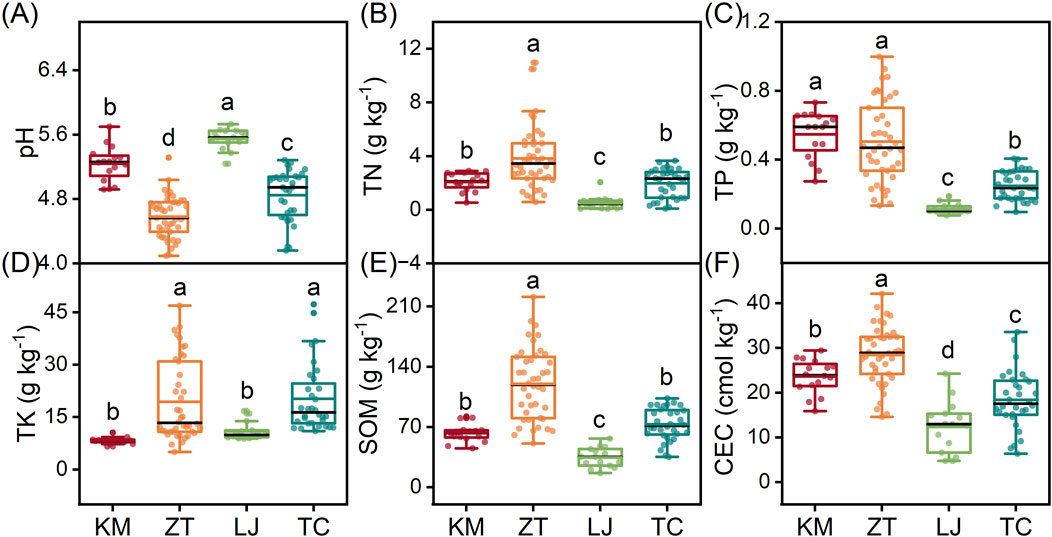
Figure 2. Changes in soil pH, total nitrogen (TN), total phosphorus (TP), total potassium (TK), organic matter (SOM) and cation exchange capacity (CEC) in different regions. (Note: (A) pH, (B) TN, (C) TP, (D) TK, (E) SOM, (F) CEC, there are statistical differences between different lowercase letters, P < 0.05, black represents the median line and the same color represents the mean line.)
Importantly, the average SOM content (84.95 g·kg-1) in the sampling areas was significantly higher than the cultivated soils in Yunnan Province, which averaged 9.15 ± 29.01 g·kg-1 (Figure 2E) (Sun et al., 2022). This difference may be attributed to organic carbon inputs from understory vegetation, litterfall, microbial activity, and tree species diversity (Adamczyk et al., 2019; Augusto and Boča, 2022; Shen et al., 2024). The highly acidic environment also inhibits microbial decomposition of organic matter, promoting SOM retention (Li et al., 2024). This phenomenon may explain why ZT exhibits the lowest pH among all sampling areas, while concurrently having the highest SOM content (Figures 2A,E).
3.2 Risk assessment of soil heavy metal pollution
3.2.1 Analysis of soil heavy metal content
As shown in Table 1, the heavy metal content in the soil of the G. elata planting area varied significantly. The concentrations of Cd, As, Pb, Hg, and Cu ranged from 0.07–1.83, 6.78–48.45, 3.60–122.27, 0.02–0.68, and 2.49–205.78 mg·kg-1, respectively, with average concentrations of 0.48, 18.56, 30.21, 0.23, and 54.58 mg·kg-1. Among the 105 sampling points, the exceedance rates of heavy metals compared to the background values of Yunnan soil followed the order of Hg > Cd > Cu > As > Pb, while the exceedance rate of Cd reached as high as 55.24%. Except for Pb, the average concentrations of the other four heavy metals exceeded their background values: 2.18 times (Cd), 1.01 times (As), 3.83 times (Cu), and 1.18 times (Hg) times the background levels, indicating potential pollution point sources in the G. elata planting area. Specifically, the average concentrations of Cd and Cu exceeded the soil pollution risk screening values for agricultural land by 1.6 and 1.09 times, respectively, while As, Pb, and Hg did not exceed the risk screening or control values (GB 15618–2018). Overall, the issue of Cd exceedance is particularly pronounced. Compared to previous studies, the issue of soil Cd exceeding standards in G. elata planting areas appears to be more severe (Jin et al., 2022).
Coefficient of variation (CV) analysis revealed that the CVs for Cd, As, Pb, Hg, and Cu were 0.93, 0.52, 0.69, 0.53, and 1.09, respectively, indicating strong variability (CV > 0.2), whereas pH exhibited weak variability (CV < 0.2) (Table 1). This suggests that the soil heavy metals in the sampling area may be influenced by varying degrees of anthropogenic interference (Chen et al., 2021; Du et al., 2024), with higher CVs for Cd and Cu indicating that their distribution is significantly impacted by human activities.
3.2.2 Analysis of heavy metal pollution index
Pollution indices, Pi and PN, are essential for assessing soil heavy metal pollution risk. By calculating the ratio of predicted no-effect concentration to exposure concentration, the risk level of heavy metals in soil can be determined (Zhang et al., 2023). According to Table 2, the pollution levels of five heavy metals were ranked as Hg > Cd > Cu > As > Pb. Notably, the Pi values for Hg and Cd were 3.78 and 2.16, respectively, while the Pi values for the remaining heavy metals were less than 2, indicating that Hg pollution is the most severe, followed by Cd. Specifically, the proportion of unpolluted from Hg was 13.33%, slightly polluted accounted for 9.52%, moderately polluted was 13.33%, and highly polluted was 63.81%; for Cd, the proportion of unpolluted was 43.81%, slightly polluted was 13.33%, moderately polluted was 17.14%, and highly polluted was 25.71%; both Cu and As had the same proportion of unpolluted (65.71%), but Cu had a 16.19% highly polluted, whereas As had highly polluted; the proportion of unpolluted for Pb was 78.10%, indicating a lower pollution risk. Thus, it is evident that Hg and Cd have a wider range of pollution, followed by Cu, while As and Pb have a smaller range of pollution.
From the perspective PN value, heavy metal pollution levels were ranked as Hg > Cd > Cu > Pb > As. Among these, Hg, Cd and Cu were classified as severely polluted, Pb as moderately polluted, and As as mildly polluted. Comparative analysis of the PN values across the four regions showed that Hg exhibited high PN levels, ranked as ZT > TC > KM > LJ, where ZT, TC and KM reflected heavy pollution, while LJ remained at a precautionary level (Figure 3). Cd pollution levels followed, with rankings of ZT > KM > LJ > TC, where both ZT and KM also indicated heavy pollution, while LJ and TC were categorized as precautionary (Figure 3). Cu and Cd displayed similar regional pollution patterns, with both ZT and KM experiencing heavy pollution (Figure 3). Notably, the non-ferrous metal smelting industry is a primary sources of heavy metal pollution, with approximately 45.6% of smelting enterprises in China located in Jiangxi, Yunnan, Henan, Guangdong, and Hunan provinces. Research indicates that ZT and its vicinity including KM are crucial zones for non-ferrous metal smelting within Yunnan province. Cd and Hg from smelting emissions can contaminate soil through atmospheric deposition (Han et al., 2023; Shao et al., 2013). Moreover, Cu from tailings in the ZT lead-zinc mining area is dispersed via runoff, increasing mobilization in acidic soils (Yu et al., 2025), contributing to elevated levels of Cd and Cu contamination.
3.2.3 Potential ecological risk assessment of heavy metals
RI is an important tool for quantitatively assessing the ecological risks of toxic metals in soil and sediments (Wang et al., 2024). As shown in Table 3, the RI values of the five heavy metals ranged from 150 to 300, indicating a moderate potential ecological risk. The values of
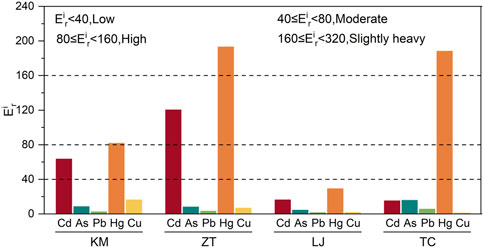
Figure 4. Single-factor potential ecological risk index (
3.2.4 Heavy metal enrichment factor analysis
The EF for the five heavy metals in the soil were as follows: Cd 0.24–6.90, As 0.17–4.75, Pb 0.06–6.47, Hg 0.28–12.95, and Cu 0.05–3.55, with EF levels ranked as Hg > Cd > As > Pb > Cu (Table 4). Among these, the proportion deemed negligible for Cd, As, Pb, and Cu was the highest (50.48%–72.38%), while moderate enrichment for Hg accounted for the largest proportion (47.62%). A comparison of EF levels across the four regions revealed notable Cd and Hg enrichment in ZT, with significant Hg and As enrichment in TC (Figure 5). The study suggests that Hg enrichment in TC may be linked to transboundary pollutants, such as emissions from coal combustion carried by the South Asian monsoon (Tripathee et al., 2019). ZT, located in the Pb-Zn polymetallic mining belt of Sichuan, Yunnan, and Guizhou, has a high baseline value of native Cd, further exacerbated by smelting emissions (Li et al., 2013). Additionally, the high SOM in ZT can adsorb Hg2+ through functional groups, such as carboxyl and phenolic hydroxyl, preventing vertical migration and resulting in surface enrichment (Li et al., 2012).
3.3 Heavy metal evaluation of Gastrodia elata
3.3.1 Analysis of heavy metal content
In the sampled G. elata tubers, except for Hg, which was not detected, the content ranges of Cd, As, Pb, and Cu were found to be 0.06–1.13, 0.01–0.04, 0.13–2.18, and 2.49–5.01 mg·kg-1, respectively, with average contents of 0.32, 0.02, 0.97, and 3.59 mg·kg-1 (Figure 6). It is worth noting that, compared to the study by Lv et al. (2016), this research found relatively high levels of Cd and Pb in the ZT area, whereas As and Cu concentrations were relatively low. According to the “Green Industry Standards for the Import and Export of Medicinal Plants and Preparations,” the exceedance rate of Cd in G. elata tubers was 37.5%, while As, Pb, and Cu levels did not exceed the limits (Table 5). According to the same standards, Jin et al. (2022) investigated the planting areas of G. elata in Yunnan (region not specified) and found that the soil exhibited slight Cd pollution, with a Cd exceedance rate of 3.1% in tubers. Our study showed that the median Cd content in tubers from the ZT area was 2.3, 3.9, and 6.6 times higher than that in the KM, LJ, and TC regions, respectively (Figure 6). ZT is primarily involved in building materials, chemical manufacturing, lignite chemical production, and mineral processing, boasting the largest coal and sulfur reserves in the province and the top three non-ferrous metal bases in Yunnan, as well as possesses the second-largest lignite field in southern China (Pang et al., 2022; Wang et al., 2022; Shao et al., 2024). These factors are likely contributed to the elevated levels of Cd pollution observed.

Table 5. Descriptive statistical analysis of heavy metal content in Gastrodia elata tubers (mg·kg-1).
3.3.2 Heavy metal enrichment capacity
Previous studies highlight that ZT has the highest enrichment coefficient for Cd in the edible parts of crops among 11 cities in Yunnan Province (Dong et al., 2022). Analysis of the heavy metal enrichment capacity in G. elata tubers revealed that these tubers exhibit the strongest capacity for Cd, with an average enrichment coefficient of 0.8100, while As exhibited the weakest, with an average enrichment coefficient of 0.0015. Except for non-detectable Hg, the average enrichment coefficients for heavy metals in G. elata tubers followed the order: Cd > Cu > Pb > As (Figure 7). Notably, despite the relatively high soil concentrations of Hg and Cu where G. elata is cultivated (Table 2), excessive accumulation of these metals in the tubers was not observed. Conversely, the accumulation of Cd in G. elata appears more influenced by total Cd content. One explanation is that acidic soils (pH < 5.5) enhance Cd availability by facilitating its desorption from soil colloids, thereby promoting absorbed by plants (Li et al., 2021). In contrast, Hg2+ tends to form stable complexes with SOM, such as Hg-SOM, which limits its bioavailability (Xu et al., 2014). Moreover, G. elata is a mycoheterotrophic plant reliant on Armillaria spp. for nutrient absorption (Liu J. J. et al., 2024). Fungal hyphae can absorb and accumulate Cd (Vinichuk et al., 2019), selectively enriching Cd2+ through membrane transport proteins (e.g., ZIP family) and transferring it to G. elata tubers via the hyphal network. In contrast, Hg and Cu may be excluded or sequestered within vacuoles by the hyphae, thus limiting their transfer to the host plant (Long et al., 2025).
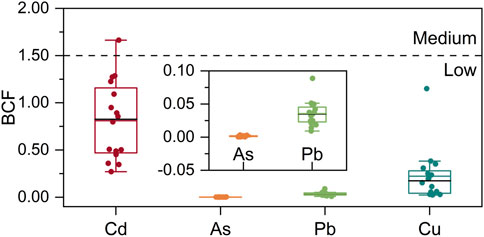
Figure 7. Bioconcentration factor (BCF) of Gastrodia elata (Note: black represents the median line and the same color represents the mean line.).
3.3.3 Health risk assessment of heavy metals in humans
Using a health risk assessment model, the HQ and HI values for heavy metal intake through G. elata tubers consumed by residents near the sampling points were calculated. The results indicated that the HQ and HI values for Cd, As, Pb, and Cu were all below 1 (Table 6). According to the National Center for Food Safety Risk Assessment’s publication, “Opinions on Managing 9 Substances as Both Food and Traditional Medicinal Materials,” the recommended daily intake of G. elata is ≤ 3 g (not suitable for pregnant women, breastfeeding women, or infants) (Zhao et al., 2018). This indicates that the risk of heavy metal contamination in G. elata is within acceptable limits. Although current health risks from heavy metals in G. elata are low, further research is needed on the long-term accumulation of heavy metals in the human body and their potential health effects.
3.4 Soil and plant correlation analysis
Certain elements may exhibit synergistic or antagonistic effects, with variations in soil heavy metal content significantly influencing their accumulation in plants (Gong et al., 2024). Correlation analysis revealed an extremely significant positive correlation of Pb (P < 0.001, R2 = 0.86) and a significant correlation of Cd (P < 0.05, R2 = 0.56) between soil and G. elata (Figure 8). Cd2+ and Pb2+ compete for ion channels in plant roots (such as Ca2+ channels) due to their similar charge; however, in acidic soils, the bioavailable forms of Cd are more readily absorbed by plants, resulting in a significantly higher Cd accumulation coefficient compared to Pb (Figure 7) (Kanwal et al., 2024). Conversely, As and Cu levels in both G. elata and the soil did not exhibit significant correlation (Figure 8). In the soil, As primarily exists in the forms such as As5+ or As3+, with its absorption by plants highly dependent on its redox state and adsorption by rhizosphere iron oxides (Chen et al., 2022). Cu tends to forms stable complexes with SOM, particularly in soils rich in high organic matter (Bradl, 2004).
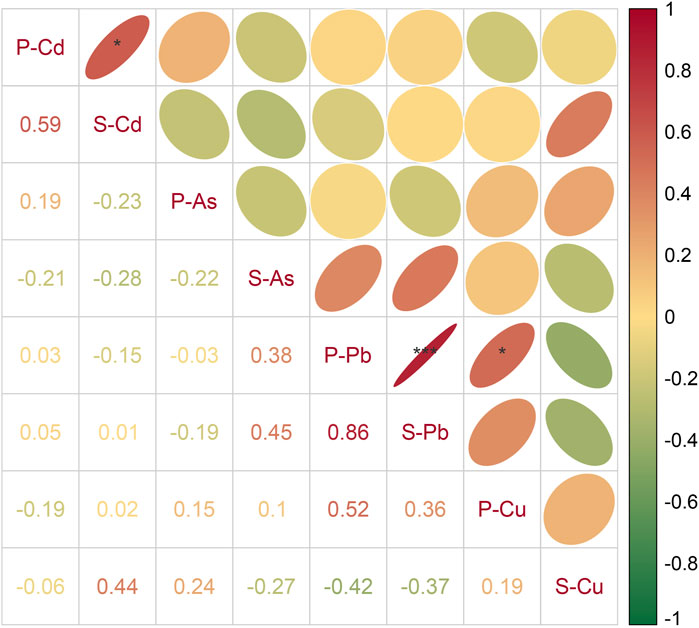
Figure 8. Heatmap of the correlation between heavy metals in soil and plants. (Note: S- represents heavy metals in soil and P- represents heavy metals in plants; *, ** and *** indicate significant correlation at the levels of 0.05, 0.01 and 0.001 respectively.).
4 Conclusion
In Yunnan Province, the degree of soil heavy metal pollution in the main G. elata planting areas follows the order: Hg > Cd > Cu > As > Pb, with a PN values ranging from 1 to 7, indicating slight to heavy pollution and a moderate potential ecological risk. The EF for the five heavy metals are ranked as Hg > Cd > As > Pb > Cu, with EF indices between 0 and 4, suggesting no enrichment to moderate enrichment. Regionally, the PN and Pi values for soil Hg and Cd are highest in the ZT area, indicating a more serious pollution risk compared to the KM, LJ and TC areas. The exceedance rate of Cd in G. elata is 37.5%, while other heavy metals remain within standard limits and do not pose a health risk. The accumulation ability of G. elata for Cd shows a significant positive correlation with soil Cd, but there is no accumulation of Hg. When selecting areas for G. elata cultivation, special attention should be given to soil levels of Hg, Cd, and Cu, and monitoring and control of Cd pollution in the ZT area should be strengthened.
Data availability statement
The original contributions presented in the study are included in the article/Supplementary Material, further inquiries can be directed to the corresponding authors.
Author contributions
XQ: Writing – review and editing, Methodology, Writing – original draft, Visualization, Data curation. YL: Methodology, Data curation, Visualization, Writing – review and editing, Writing – original draft. HY: Methodology, Writing – review and editing, Data curation. JW: Methodology, Writing – review and editing, Data curation. HZ: Data curation, Methodology, Writing – review and editing. HS: Methodology, Writing – review and editing, Data curation. QL: Writing – review and editing. ZS: Writing – review and editing. BH: Writing – review and editing, Supervision, Writing – original draft. WF: Supervision, Writing – original draft, Writing – review and editing.
Funding
The author(s) declare that financial support was received for the research and/or publication of this article. This work was supported by the National Key Research and Development Program Project Supported by the Scientific Research Fund of Yunnan Education Department (2022YFD1601810).
Conflict of interest
The authors declare that the research was conducted in the absence of any commercial or financial relationships that could be construed as a potential conflict of interest.
Generative AI statement
The author(s) declare that no Generative AI was used in the creation of this manuscript.
Publisher’s note
All claims expressed in this article are solely those of the authors and do not necessarily represent those of their affiliated organizations, or those of the publisher, the editors and the reviewers. Any product that may be evaluated in this article, or claim that may be made by its manufacturer, is not guaranteed or endorsed by the publisher.
Supplementary material
The Supplementary Material for this article can be found online at: https://www.frontiersin.org/articles/10.3389/fenvs.2025.1602385/full#supplementary-material
References
Adamczyk, B., Sietiö, O. M., Straková, P., Prommer, J., Wild, B., Hagner, M., et al. (2019). Plant roots increase both decomposition and stable organic matter formation in boreal forest soil. Nat. Commun. 10 (1), 3982. doi:10.1038/s41467-019-11993-1
Augusto, L., and Boča, A. (2022). Tree functional traits, forest biomass, and tree species diversity interact with site properties to drive forest soil carbon. Nat. Commun. 13 (1), 1097. doi:10.1038/s41467-022-28748-0
Barbieri, M. (2016). The importance of enrichment factor (EF) and geoaccumulation index (igeo) to evaluate the soil contamination. J. Geol. Geophys. 5 (1), 1–4. doi:10.4172/2381-8719.1000237
Bradl, H. B. (2004). Adsorption of heavy metal ions on soils and soils constituents. J. Colloid. Interface Sci. 277, 1–18. doi:10.1016/j.jcis.2004.04.005
Chen, G. G., Du, Y. H., Fang, L. P., Wang, X. Q., Liu, C. P., Yu, H. Y., et al. (2022). Distinct arsenic uptake feature in rice reveals the importance of N fertilization strategies. Sci. Total Environ. 854, 158801. doi:10.1016/j.scitotenv.2022.158801
Chen, W. D., Zhu, K., Cai, Y. K., Wang, Y. L., and Liu, Y. P. (2021). Distribution and ecological risk assessment of arsenic and some trace elements in soil of different land use types, tianba town, China. Environ. Technol. Innov. 24, 102041. doi:10.1016/j.eti.2021.102041
Chen, Y., and Deng, Z. H. (2025). Heavy metal pollution in Gastrodia elata planting soil and remediation strategies. Agric. Technol. 45 (9), 6–11. doi:10.19754/j.nyyjs.20250515002
Chen, Y. W., Zou, J. Y., Sun, H., Qin, J. H., and Yang, J. Y. (2020). Metals in traditional chinese medicinal materials (TCMM): a systematic review. Ecotoxicol. Environ. Saf. 207, 111311. doi:10.1016/j.ecoenv.2020.111311
China National Environmental Monitoring Center (1990). Background value of soil elements in China. Beijing: China Environmental Science Press.
Dong, C. Y., Zhang, M., Zhang, H., Yang, H. C., Li, J. Q., Tan, F. M., et al. (2022). Heavy metal characteristics and comprehensive quality index evaluation of soil-crop system in 11 cities of Yunnan province, China. J. Geosci. Environ. Prot. 10, 257–272. doi:10.4236/gep.2022.104016
Dong, H. Z., Gao, Z. J., Liu, J. T., and Jiang, B. (2023). Study on the accumulation of heavy metals in different soil-crop systems and ecological risk assessment: a case study of jiao river basin. Agronomy 13 (9), 2238. doi:10.3390/agronomy13092238
Du, H. M., Lu, X. W., and Han, X. F. (2024). Determination of priority control factors for risk management of heavy metal(loid)s in park dust in mianyang city. Sci. Rep. 14 (1), 27440. doi:10.1038/s41598-024-79157-w
Ekor, M. (2014). The growing use of herbal medicines: issues relating to adverse reactions and challenges in monitoring safety. Front. Pharmacol. 4, 177. doi:10.3389/fphar.2013.00177
Fei, Y. Q., Xiao, L., Wang, B., Zhu, H. L., and Nie, J. (2021). Residue analysis and risk assessment of heavy metals and harmful elements in 37 plant medicinal materials. Chin. J. Pharm. Anal. 41 (6), 1000–1008. doi:10.16155/j.0254-1793.2021.06.09
Ferrol, N., Tamayo, E., and Vargas, P. (2016). The heavy metal paradox in arbuscular mycorrhizas: from mechanisms to biotechnological applications. J. Exp. Bot. 67 (22), 6253–6265. doi:10.1093/jxb/erw403
Gao, W. Y., Xiang, C., Wu, C., Li, X., Zhang, W., Tang, L., et al. (2024). Unveiling heavy metal(loid) contamination and migration at an abandoned smelting site: integrated geophysical and hydrological analyse. Chem. Eng. J. 500, 156853. doi:10.1016/j.cej.2024.156853
Gong, Y. F., Ren, W., Li, F. P., Jiang, Y. C., and Zhang, Z. M. (2024). The role of soil elemental forms in the soil-plant migration system: an example of heavy metals in epimedium production areas. Environ. Technol. Innov. 36, 103800. doi:10.1016/j.eti.2024.103800
Goswami, V., Deepika, S., Diwakar, S., and Kothamasi, D. (2023). Arbuscular mycorrhizas amplify the risk of heavy metal transfer to human food chain from fly ash ameliorated agricultural soils. Environ. Pollut. 329, 121733. doi:10.1016/j.envpol.2023.121733
Hakanson, L. (1980). An ecological risk index for aquatic pollution control: a sedimentological approach. Water Res. 14 (8), 975–1001. doi:10.1016/0043-1354(80)90143-8
Hamer, M. (2024). Assessing the resilience of soils to acidification on different time scales. Environ. Anal. Eco Stud. 11 (5), 000772. doi:10.31031/EAES.2024.11.000772
Han, X. Y., Guo, J. Y., Shi, J. W., Li, D. S., Wang, Y. M., Ning, P., et al. (2023). Characterization and health risk of heavy metals in PM2.5 from road fugitive dust in five cities of Yunnan province. Environ. Sci. 44 (6), 3463–3474. doi:10.13227/j.hjkx.202207173
Harris, E. S., Cao, S. G., Littlefield, B. A., Craycroft, J. A., Scholten, R., Kaptchuk, T., et al. (2011). Heavy metal and pesticide content in commonly prescribed individual raw Chinese herbal medicines. Sci. Total Environ. 409 (20), 4297–4305. doi:10.1016/j.scitotenv.2011.07.032
Hu, Y. B., Zeng, H. L., Huang, J. H., Jiang, L., Chen, J., and Zeng, Q. H. (2020). Traditional Asian herbs in skin whitening: the current development and limitations. Front. Pharmacol. 11, 982. doi:10.3389/fphar.2020.00982
Huang, W. J., Liang, Y. F., Tang, D., Zhang, Q., L, D. D., and Wang, Q. Y. (2025). Influence of introduction and cultivation on the content of active ingredients and elements in Gastrodia elata. Sci. Technol. Food Industry 46 (07), 283–290. doi:10.13386/j.issn1002-0306.2024110405
Huang, X. L., Tan, C. R., Zhu, D. W., Y, L. J., and Zheng, R. (2024). Analysis of exogenous pollutants of Gastrodia elata and Ganoderma lucidum. Chem. Reagents 46 (03), 73–80. doi:10.13822/j.nki.hxsj.2023.075000001006
Ji, C., Huang, J., Li, J., Zhang, X., Yang, G., Ma, Y., et al. (2023). Deciphering the impacts of chromium contamination on soil bacterial communities: a comparative analysis across various soil types. J. Environ. Manage. 348, 119335. doi:10.1016/j.jenvman.2023.119335
Jin, Z. Q., Shang, B. P., Zhang, G. X., Cui, X. M., Guo, L. P., Du, P., et al. (2022). Safety evaluation of three Yunnan medicinal materials, Gastrodia elata, Polygonatum sibiricum and maca, and heavy metals in their planting soil. China Mod. Chin. Med. 24 (8), 1525–1530. doi:10.13313/j.issn.1673-4890.20210617003
Kanwal, F., Riaz, A., Ali, S., and Zhang, G. (2024). NRAMPs and manganese: magic keys to reduce cadmium toxicity and accumulation in plants. Sci. Total Environ. 921, 171005. doi:10.1016/j.scitotenv.2024.171005
Korkanç, S. Y., Korkanç, M., and Amiri, A. F. (2024). Effects of land use/cover change on heavy metal distribution of soils in wetlands and ecological risk assessment. Sci. Total Environ. 923, 171603. doi:10.1016/j.scitotenv.2024.171603
Kuang, H. F., Hu, C. H., Wu, G. L., and Chen, M. (2020). Combination of PCA and PMF to apportion the sources of heavy metals in surface sediments from Lake poyang during the wet season. J. Lake Sci. 32 (4), 964–976. doi:10.18307/2020.0406
Li, J. Y., Cheng, H., Liang, X. M., Chen, Y. L., Wu, S. W., and Hu, C. X. (2024). Research progress on acidified soil improvement and carbon fixation. Acta Ecol. Sin. 44 (17), 7871–7884. doi:10.20103/j.stxb.202312252817
Li, P., Feng, X., Qiu, G., Shang, L., and Wang, S. (2012). Mercury pollution in wuchuan Mercury mining area, Guizhou, Southwestern China: the impacts from large scale and artisanal Mercury mining. Environ. Int. 42, 59–66. doi:10.1016/j.envint.2011.04.008
Li, Z. M., Liang, Y., Hu, H. W., Shaheen, S. M., Zhong, H., Tack, F. G., et al. (2021). Speciation, transportation, and pathways of cadmium in soil-rice systems: a review on the environmental implications and remediation approaches for food safety. Environ. Int. 156, 106749. doi:10.1016/j.envint.2021.106749
Li, Z. Y., Ma, Z. W., Kuijp, T., Yuan, Z. W., and Huang, L. (2013). A review of soil heavy metal pollution from mines in China: pollution and health risk assessment. Sci. Total Environ. 468-469, 843–853. doi:10.1016/j.scitotenv.2013.08.090
Lima, L. H. V., da Silva, F. B. V., da Silva, Y. J. A. B., de Lima Veloso, V., de Sousa, M. G. F., de Souza Junior, V. S., et al. (2024). Integrating environmental, ecological and human health risk assessments for heavy metals in tropical ultramafic soils. Sci. Total Environ. 957, 177343. doi:10.1016/j.scitotenv.2024.177343
Liu, J. J., Yang, X. Q., Li, Z. Y., Miao, J. Y., Li, S. B., Zhang, W. P., et al. (2024a). The role of symbiotic fungi in the life cycle of Gastrodia elata blume (orchidaceae): a comprehensive review. Front. Plant Sci. 14, 1309038. doi:10.3389/fpls.2023.1309038
Liu, X. Y., Zhang, G. X., Tian, M. H., Zhang, C. F., Yu, X. L., Guo, Y. G., et al. (2015). Determination and comparison of gastrodin content between different grades of zhaotong Black Gastrodia elata and Gastrodia elata from other places. Chin. Mod. Chin. Med. 17 (1), 35–38. doi:10.13313/j.issn.1673-4890.2015.1.009
Liu, Y., Fu, K. Z., Leng, A. J., Zhang, L., and Qu, J. L. (2024b). Spotlight on the accumulation of heavy metals in Traditional Chinese medicines: a holistic view of pollution status, removal strategies and prospect. Sci. Total Environ. 953, 176025. doi:10.1016/j.scitotenv.2024.176025
Liu, Z. X., Wang, Z. T., Zhao, D. Q., Wu, G., Ling, J., Zhou, S. L., et al. (2023). Effects of soil warming and straw returning on soil nutrients and extracellular enzyme activities. Acta Ecol. Sin. 43 (23), 9867–9876. doi:10.20103/j.stxb.202211193352
Long, X. N., Zhang, X. K., Wu, Y., You, X. X., Tang, S. S., Zheng, T. X., et al. (2025). Research progress on the mechanism of arbuscular mycorrhizal fungi improving the resistance of medicinal plants to cadmium stress. Chin. Herb. Med. 56 (4), 1477–1488. doi:10.7501/j.issn.0253-2670.2025.04.034
Lu, C. C., Qu, S. H., Zhong, Z. F., Luo, H., Lei, S. S., Zhong, H. J., et al. (2022). The effects of bioactive components from the rhizome of Gastrodia elata blume (tianma) on the characteristics of Parkinson’s disease. Front. Pharmacol. 13, 963327. doi:10.3389/fphar.2022.963327
Lu, J., Gao, L., and Wang, H. Y. (2024). Contamination characteristics of heavy metals and enrichment capacity of native plants in soils around typical coal mining areas in Gansu, China. Sci. Rep. 14 (1), 29983–14. doi:10.1038/s41598-024-81740-0
Luan, S., Zhao, Y. C., Han, C. H., and Dou, J. (2015). Determination and analysis of residuals of lead and cadmium in 77 kinds of Chinese herbal medicines. China Pharm. 26 (12), 1678–1681. doi:10.6039/j.issn.1001-0408.2015.12.33
Luo, L., Wang, B., Jiang, J. W., Fitzgerald, M., Huang, Q., Yu, Z., et al. (2021). Heavy metal contaminations in herbal medicines: determination, comprehensive risk assessments, and solutions. Front. Pharmacol. 11, 595335. doi:10.3389/fphar.2020.595335
Lv, Z. X., Xiang, P. Y., Chen, J., and Tang, Y. (2016). Determination of lead, cadmium, arsenic, Mercury and copper in 14 batches of cultivated Gastrodia elata. China Pharm. 25 (11), 65–68.
Ministry of Ecology and Environment of the People's Republic of China (2023). Soil and sediment-Determination of 19 total metal elements-inductively coupled plasma mass spectrometry: HJ 1315—2023.
Ministry of Environmental Protection of People's Republic of China (PRC) (2013). Soil and sedimen-Determination of Mercury,arsenic,selenium,bismuth,antimony-Microwave Dissolution/atomic fluorescence spectrometry: HJ 680—2013.
National Health and Family Planning Commission of the People's Republic of China, China Food and Drug Administration (CFDA) (2016). Determination of multi-elements in food by national standard for food safety: GB 5009, 268–2016.
National Health and Family Planning Commission of the People's Republic of China (2014). “Determination of total arsenic and inorganic arsenic,” in Food as national standard for food safety: GB 5009, 11–2014.
National Health and Family Planning Commission of the People's Republic of China, China Food and Drug Administration (CFDA) (2021). Determination of total mercury and organic mercury in food: GB 5009, 17–2021.
National Pharmacopoeia Committee (2020). People's Republic of China (PRC) pharmacopoeia: part one. Beijing: China Medical Science and Technology Press.
Pang, X. C., Han, X. Y., Shi, J. W., Bao, Y. Z., Ning, P., Zhang, C. N., et al. (2022). Pollution characteristics and health risk of heavy metals in fugitive dust around zhaotong city. Huan Jing Ke Xue 43 (1), 180–188. doi:10.13227/j.hjkx.202106018
Ruan, X. L., Ge, S. J., Jiao, Z. Q., Zhan, W. H., and Wang, Y. Y. (2023). Bioaccumulation and risk assessment of potential toxic elements in the soil-vegetable system as influenced by historical wastewater irrigation. Agric. Water Manag. 279, 108197. doi:10.1016/j.agwat.2023.108197
Shao, F. L., Li, K. N., Ouyang, D., Zhou, J. W., Luo, Y. T., and Zhang, H. B. (2024). Sources apportionments of heavy metal(loid)s in the farmland soils close to industrial parks: integrated application of positive matrix factorization (PMF) and cadmium isotopic fractionation. Sci. Total Environ. 924, 171598. doi:10.1016/j.scitotenv.2024.171598
Shao, X., Cheng, H. G., Li, Q., and Lin, C. (2013). Anthropogenic atmospheric emissions of cadmium in China. Atmos. Environ. 79, 155–160. doi:10.1016/j.atmosenv.2013.05.055
Shen, K. H., Li, L., Wei, S. G., Liu, J. R., and Zhao, Y. (2024). A network meta-analysis on responses of forest soil carbon concentration to interventions. Ecol. Process. 13 (1), 41. doi:10.1186/s13717-024-00513-9
Sun, J., Zhu, D., Lu, Y., Chen, P. C., Xiong, K., and Lan, Y. Y. (2016). Residue analysis of heavy metals and harmful elements in soil and Gastrodia elata in Gastrodia elata planting base. Chin. J. Exp. Tradit. Med. Formulae 22 (12), 32–36. doi:10.13422/j.cnki.syfjx.2016120032
Sun, T., Tong, W. J., Chang, N. J., Deng, A. X., Lin, Z. L., Feng, X. B., et al. (2022). Estimation of soil organic carbon stock and its controlling factors in cropland of Yunnan province, China. J. Integr. Agric. 21 (5), 1475–1487. doi:10.1016/S2095-3119(21)63620-1
Tang, L., Liu, J., Zeng, J. Q., Luo, X. H., Ke, W. S., Li, C. X., et al. (2023). Anthropogenic processes drive heterogeneous distributions of toxic elements in shallow groundwater around a smelting site. J. Hazard. Mat. 453, 131377. doi:10.1016/j.jhazmat.2023.131377
Tian, M. H., Wang, J. J., Zhang, G. X., Dai, K., Liu, X. Y., Zhang, C. F., et al. (2016). Characteristics and evaluation of soil fertility in different producing areas of Gastrodia elata in zhaotong, Yunnan. J. Southwest. Agric. 29 (11), 2653–2659. doi:10.16213/j.cnki.scjas.2016.11.026
Tong, S. M., Yang, L. S., Gong, H. Q., Wang, L., Li, H. R., Yu, J. P., et al. (2022). Bioaccumulation characteristics, transfer model of heavy metals in soil-crop system and health assessment in Plateau region, China. Ecotoxicol. Environ. Saf. 241, 113733. doi:10.1016/j.ecoenv.2022.113733
Tripathee, L., Guo, J., Kang, S., Paudyal, R., Huang, J., Sharma, C. M., et al. (2019). Spatial and temporal distribution of total Mercury in atmospheric wet precipitation at four sites from the nepal-himalayas. Sci. Total Environ. 655, 1207–1217. doi:10.1016/j.scitotenv.2018.11.338
Vinichuk, M. M., Skyba, G. V., Yelnikova, T. O., and Mandro, Y. N. (2019). Bioaccumulation of selected metals and non-metals in mycelium and fruit bodies of ectomycorrhizal fungi. Visnyk Kharkiv Univ. Ser. Ecol. 20, 23–31. doi:10.26565/1992-4259-2019-20-02
Wang, N., Liu, Z., Sun, Y., Lu, N., and Luo, Y. (2024). Analysis of soil fertility and toxic metal characteristics in open-pit mining areas in northern Shaanxi. Sci. Rep. 14 (1), 2273. doi:10.1038/s41598-024-52886-8
Wang, N., Luo, Y. H., Liu, Z., and Sun, Y. Y. (2022). Spatial distribution characteristics and evaluation of soil pollution in coal mine areas in loess Plateau of northern Shaanxi. Sci. Rep. 12 (1), 16440. doi:10.1038/s41598-022-20865-6
Wang, Y. H., Xu, J., Yuan, Q. S., Guo, L. P., Xiao, C. H., Yang, C. G., et al. (2023). Effect of symbiotic fungi-Armillaria gallica on the yield of Gastrodia elata bl. And insight into the response of soil microbial community. Front. Microbiol. 14, 1233555. doi:10.3389/fmicb.2023.1233555
Wang, Z. Z., Wang, H. B., Wang, H. J., Li, Q. C., and Li, Y. (2019). Heavy metal pollution and potential health risks of commercially available Chinese herbal medicines. Sci. Total Environ. 653, 748–757. doi:10.1016/j.scitotenv.2018.10.388
Wen, H. T., Dong, Q. Y., Wang, P., Song, C., Yang, Z. J., Zhao, Y. Y., et al. (2023). Spatial variation characteristics and influencing factors of soil pH value at the northern foot of tongbai Mountain. Chin. J. Soil Sci. 54 (2), 295–305. doi:10.19336/j.cnki.trtb.2022022401
Xu, J. J., Ceng, J., Dong, W. J., Chen, J. L., Hu, Y. D., Xu, Y. Y., et al. (2018). Difference analysis of heavy metal elements in Gastrodia elata planting soil in zhaotong area, Yunnan province. soil Sci. 6 (4), 115–124. doi:10.12677/hjss.2018.200181888876
Xu, L., Guan, J. Y., Ba, Y., Chen, W. Z., Huang, J. Z., Cheng, Y. X., et al. (2024). Spatial distribution pattern and driving mechanism of heavy metal elements in soils of middle-alpine hilly region, Yunnan province. Geol. China 51 (1), 304–326. doi:10.12029/gc20230427003
Xu, W. M., Wu, F. Y., Wang, H. J., Zhao, L. Y., Liu, X., Xiang, P., et al. (2021). Key soil parameters affecting the survival of Panax notoginseng under continuous cropping. Sci. Rep. 11 (1), 5656. doi:10.1038/s41598-021-85171-z
Xu, Z. Y., Bravo, A. G., Lagerkvist, A., Bertilsson, S., Sjöblom, R., and Kumpiene, J. (2014). Sources and remediation techniques for Mercury contaminated soil. Environ. Int. 74, 42–53. doi:10.1016/j.envint.2014.09.007
Yan, H., Chen, J., and Du, J. M. (2024). Heavy metal contamination and ecological risk assessment of soil around quandian coal mine, Henan Province of China. Appl. Ecol. Environ. Res. 22 (3), 2367–2376. doi:10.15666/aeer/2203_23672376
Yan, H. Y., Gong, W. L., Liu, Y., Zhou, T., Guo, L. P., Peng, H. S., et al. (2021). Analysis and evaluation of mineral elements in Gastrodia elata from different habitats and specifications. Chin. J. Exp. Tradit. Med. Formulae 27 (12), 147–156. doi:10.13422/j.cnki.syfjx.20210719
Yang, C. M., Chien, M. Y., Chao, P. C., Huang, C. M., and Chen, C. H. (2021). Investigation of toxic heavy metals content and estimation of potential health risks in Chinese herbal medicine. J. Hazard. Mat. 412, 125142. doi:10.1016/j.jhazmat.2021.125142
Yin, Z., Zhang, Y., Hu, N., Shi, Y., Li, T., and Zhao, Z. (2021). Differential responses of 23 maize cultivar seedlings to an arbuscular mycorrhizal fungus when grown in a metal-polluted soil. Sci. Total Environ. 789, 148015. doi:10.1016/j.scitotenv.2021.148015
Yu, Q., Gao, B., and Zhang, X. (2025). Agricultural wastes improve soil quality and enhance the phytoremediation efficiency of economic crops for heavy metal-contaminated soils in mining areas. Environ. Geochem. Health. 47, 65. doi:10.1007/s10653-025-02381-4
Yuan, Y., Wen, Q., Zhao, X., Liu, S., Zhu, K., and Hu, B. (2022). Identifying grassland distribution in a mountainous region in southwest China using multi-source remote sensing images. Remote Sens. 14 (6), 1472. doi:10.3390/rs14061472
Zhan, H. D., Zhou, H. Y., Sui, Y. P., Du, X. L., Wang, W. H., Dai, L., et al. (2016). The rhizome of Gastrodia elata Blume–An ethnopharmacological review. J. Ethnopharmacol. 189, 361–385. doi:10.1016/j.jep.2016.06.057
Zhang, A., Sun, H., and Wang, X. (2013). Recent advances in natural products from plants for treatment of liver diseases. Eur. J. Med. Chem. 63, 570–577. doi:10.1016/j.ejmech.2012.12.062
Zhang, J., Liu, Z., Tian, B., Li, J., Luo, J., Wang, X., et al. (2023). Assessment of soil heavy metal pollution in provinces of China based on different soil types: from normalization to soil quality criteria and ecological risk assessment. J. Hazard. Mat. 441, 129891. doi:10.1016/j.jhazmat.2022.129891
Zhang, L., Zhang, N. M., Zhang, Y. J., Deng, H., and Yang, H. Y. (2021a). Spatial distribution of selenium content in cultivated soil in Yunnan and its influencing factors. Soil 53 (3), 578–584. doi:10.13758/j.cnki.tr.2021.03.018
Zhang, M., Wang, C., Zhang, R., Chen, Y., Zhang, C., Heidi, H., et al. (2021b). Comparison of the guidelines on good agricultural and collection practices in herbal medicine of the european union, China, the WHO, and the United States of America. Pharmacol. Res. 167, 105533. doi:10.1016/j.phrs.2021.105533
Zhang, Y. L., Song, D., and Zheng, X. W. (2018). Determination of heavy metals and harmful elements in Gastrodia elata from different habitats by ICP-MS. Electromech. Inf. (14), 44–47. doi:10.19514/j.cnki.cn32-1628/tm.2018.14.009
Zhao, X. H., Xu, Y., Lin, J., and Xu, D. X. (2018). Evaluation and analysis of various metal elements in fresh Gastrodia elata in xiaocaoba. J. Food Saf. Qual. Insp. 9 (22), 5987–5992. doi:10.3969/j.issn.2095-0381.2018.22.032
Zhaotong Municipal People's Government (2023). Bulletin of zhaotong municipal people's government. Zhaotong: Zhaotong Municipal People's Government Office.
Zhong, X. L., Zhou, S. L., Zhu, Q., and Zhao, Q. G. (2011). Fraction distribution and bioavailability of soil heavy metals in the yangtze river Delta—A case study of kunshan city in Jiangsu Province, China. J. Hazard. Mat. 198, 13–21. doi:10.1016/j.jhazmat.2011.10.003
Keywords: Gastrodia elata, heavy metal contamination, Yunnan Province, soil-plant system,, health risk assessment
Citation: Qian X, Luo Y, Yang H, Wang J, Zhang H, Shi H, Li Q, Song Z, Hao B and Fan W (2025) Assessment and analysis of heavy metal pollution in key production areas of Gastrodia elata in Yunnan, China. Front. Environ. Sci. 13:1602385. doi: 10.3389/fenvs.2025.1602385
Received: 29 March 2025; Accepted: 10 July 2025;
Published: 01 August 2025.
Edited by:
Zhenming Zhang, Guizhou University, ChinaReviewed by:
Sinem Çolak, Bülent Ecevit University, TürkiyeYunfei Hu, Bozhou University, China
Ziyu Guo, Guizhou Centre for Disease Control and Prevention, China
Copyright © 2025 Qian, Luo, Yang, Wang, Zhang, Shi, Li, Song, Hao and Fan. This is an open-access article distributed under the terms of the Creative Commons Attribution License (CC BY). The use, distribution or reproduction in other forums is permitted, provided the original author(s) and the copyright owner(s) are credited and that the original publication in this journal is cited, in accordance with accepted academic practice. No use, distribution or reproduction is permitted which does not comply with these terms.
*Correspondence: Bing Hao, QmluZy5IYW9AeW5hdS5lZHUuY24=; Wei Fan, ZmFud2VpMTEyOEBhbGl5dW4uY29t
†These authors have contributed equally to this work
 Xixi Qian1,2,3†
Xixi Qian1,2,3† Yu Luo
Yu Luo Huineng Shi
Huineng Shi Qi Li
Qi Li Bing Hao
Bing Hao